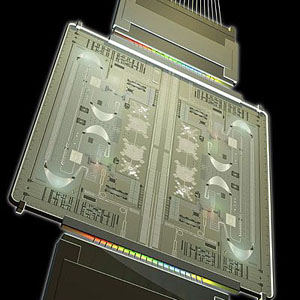Higher performance electrical and optical integrated circuits come closer to reality
 Washington, March 20 : Scientists at the University of Illinois have moved a step closer to realising higher speed electronics and higher performance electrical and optical integrated circuits, for they have successfully created a microwave signal mixer made from a tunnel-junction transistor laser.
Washington, March 20 : Scientists at the University of Illinois have moved a step closer to realising higher speed electronics and higher performance electrical and optical integrated circuits, for they have successfully created a microwave signal mixer made from a tunnel-junction transistor laser.
The researchers have revealed that their mixing device accepts two electrical inputs, and produces an optical signal that was measured at frequencies of up to 22.7 gigahertz.
They say that the frequency range was limited by the bandwidth of the detector employed in the measurements, not by the transistor device.
"In addition to the usual current-modulation capability, the tunnel junction provides an enhanced means for voltage-controlled modulation of the photon output of the transistor laser. This offers new capabilities and a much greater sensitivity for unique signal-mixing and signal-processing applications," said Nick Holonyak Jr., a John Bardeen Chair Professor of Electrical and Computer Engineering and Physics.
For making the device, the research team placed a quantum well inside the base region of a transistor laser, and then created a tunnel junction within the collector region.
"Within the transistor laser, the tunnelling process occurs predominantly through a process called photon-assisted absorption," said Milton Feng, the Holonyak Chair Professor of Electrical and Computer Engineering.
According to Feng, the tunnelling process begins in the quantum well, where electrons and holes combine and generate photons, which are then reabsorbed to create new pairs of electrons and holes used for voltage modulation.
"The tunnel junction makes it possible to annihilate an electron in the quantum well, and then tunnel an electron out to the collector by the tunnel contact," Feng said.
The transistor output is sensitive to third-terminal voltage control because of the electrons tunneling from the base to the collector, which also creates an efficient supply of holes to the quantum well for recombination.
"We are using the photon internally to modify the electrical operation and make the transistor itself a different device with additional properties," said Holonyak, who also is a professor in the university''s Center for Advanced Study, one of the highest forms of campus recognition.
According to the researchers, high-speed signal mixing is made possible by the nonlinear coupling of the internal optical field to the base electron-hole recombination, minority carrier emitter-to-collector transport, and the base-to-collector electron tunneling at the collector junction.
The sensitivity of the tunnel-junction transistor laser to voltage control enables the device to be directly modulated by both current and voltage.
The researchers say that this flexibility facilitates the design of new non-linear signal processing devices for improved optical power output.
"The metamorphosis of the transistor is not yet complete. We''re still working on it, and the transistor is still changing," Holonyak said.
The fabrication and operation of the mixing device has been described in the journal Applied Physics Letters. (ANI)